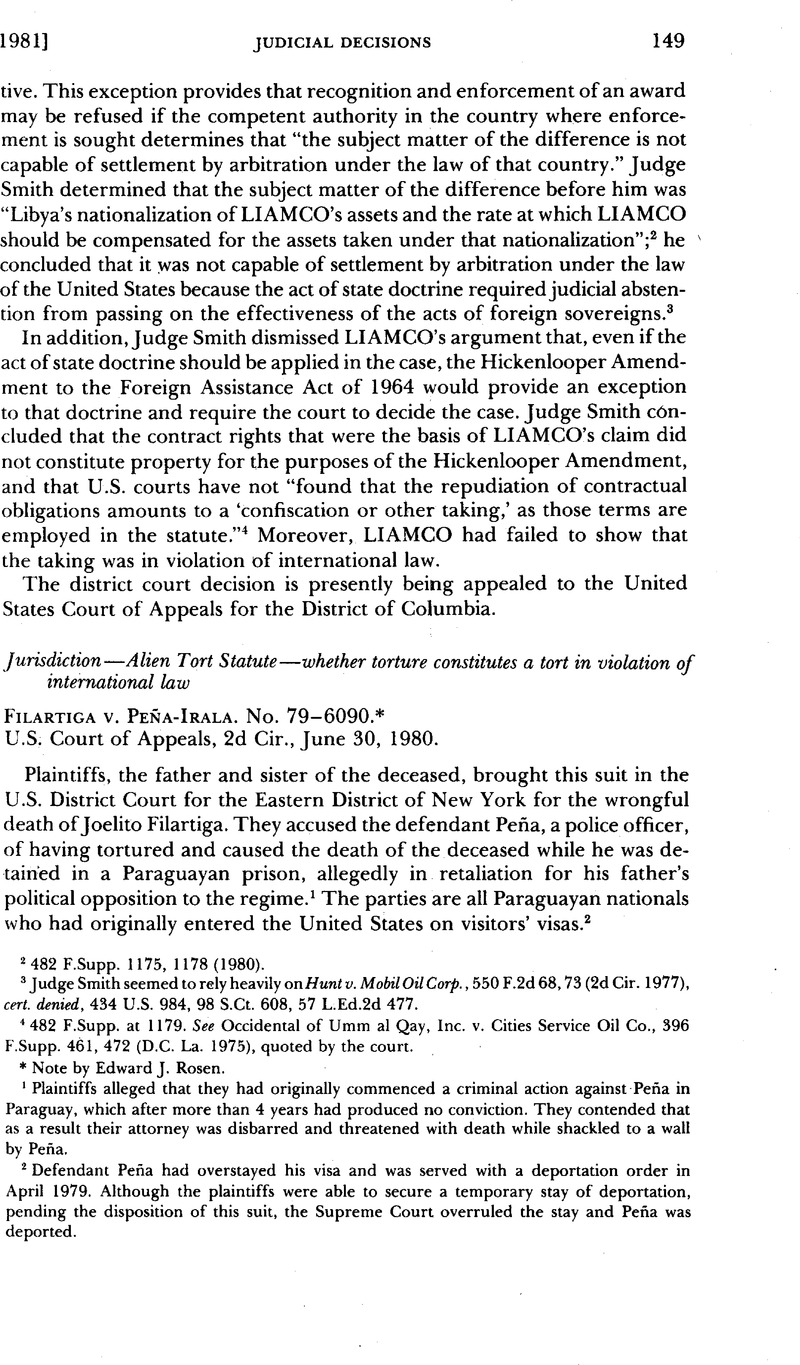No CrossRef data available.
Article contents
Abstract

- Type
- Judicial Decisions
- Information
- Copyright
- Copyright © 1981 The American Society of International Law
Footnotes
Note by Edward J. Rosen.
References
1 Plaintiffs alleged that they had originally commenced a criminal action against Pena in Paraguay, which after more than 4 years had produced no conviction. They contended that as a result their attorney was disbarred and threatened with death while shackled to a wall by Pena.
2 Defendant Pena had overstayed his visa and was served with a deportation order in April 1979. Although the plaintiffs were able to secure a temporary stay of deportation, pending the disposition of this suit, the Supreme Court overruled the stay and Pena was deported.
3 No. 79-6090 (2d Cir. June 30, 1980), slip op. at 7.
4 Id.at 8.
5 Id. at 9-10, quoting175 U.S. 667, 694 (1900).
6 Slip op. at 10.
7 Memorandum for the United States as Amicus Curiae,Filartiga v. Peña-Irala, No. 79-6090, reprinted in19 ILM 585 (1980).
8 Seethe American Convention on Human Rights, Nov. 22, 1969, OAS TS 36, OAS, OR, OEA/Ser.A/16; the International Covenant on Civil and Political Rights, GA Res. 2200A (XXI) (Dec. 16, 1966); the European Convention for the Protection of Human Rights and Fundamental Freedoms, Nov. 4, 1950, [1968] ETS 5, 213 UNTS 221; the Geneva Convention Relative to the Treatment of Prisoners of War of Aug. 12, 1949, 6 UST 3316, TIAS No. 3364, 75 UNTS 135, cited by the Government.
9 Memorandum for the United States, supranote 7, at 13 n.28.
10 The Government focused its argument primarily on the Universal Declaration of Human Rights, GA Res. 217A (III) of Dec. 10, 1948, and the Declaration on the Protection of All Persons from Being Subjected to Torture and Other Cruel, Inhuman or Degrading Treatment or Punishment, GA Res. 3452 (XXX) of Dec. 9, 1975. The Government also noted that 55 national constitutions prohibited torture and argued that the prohibition was therefore a general principle of law.
11 Slip op. at 13. The quoted passage is taken from the Memorandum of the Office of Legal Affairs, UN Secretariat,'34 UN ESCOR, Supp. (No. 8) 15, UN Doc. FVCN.4/1/610 (1962).
12 Slip op. at 13. See alsoNayar, Human Rights: The United Nations and United States Foreign Policy,19 HARV. INT'L L.J. 813, 816 n.18 (1978); Waldock, , Human Rights in Contemporary International Law and the Significance of the European Convention, INT'L & COMP. L.Q., Supp. Pub. No. 11, at 15 (1965)Google Scholar, cited by the court.
13 Slip op. at 13.
14 .Id. at n.15.
15 Id.at 19.
16 Id.at 18. See also1 Blackstone Commentaries 263-64 (1st ed. 1765-1769), cited by the court.
17 Slip op. at 16.
18 Ibid. SeeMcKenna v. Fisk, 42 U.S. (1 How.) 241, 248 (1843); Mostyn v. Fabrigas, 1 Cowp. 161 (1774), cited by the court.
19 See supranote 1. These allegations will undoubtedly complicate the court's consideration of the removal motion.
20 Slip op. at 22. SeeI IT v. Vencap, 519 F.2d 1001, 1015 (2d Cir. 1975), quoted by the court.
21 Slip op. at 26.


